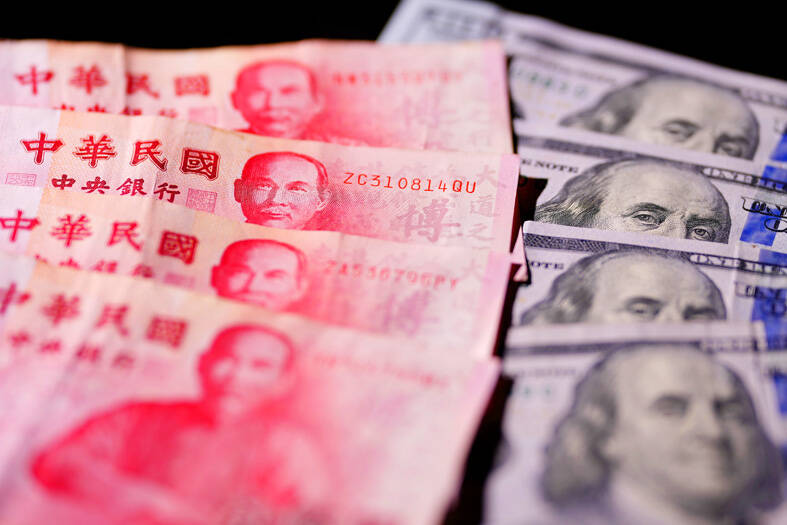A recent article in The Economist arguing that the central bank has long kept the New Taiwan dollar undervalued has sparked debate among officials and academics, who say the analysis overlooks major shifts in Taiwan’s industrial structure.
The magazine used its Big Mac Index to claim the central bank’s currency policy has weakened purchasing power, driven up housing prices and created financial risks — a view that National Development Council (NDC) Minister Yeh Chun-hsien (葉俊顯) said fails to reflect how Taiwan’s export mix has changed over the past 30 to 40 years.
Yeh on Wednesday said that Taiwan’s industries were once dominated by traditional manufacturing, but the rise of semiconductors and upgraded conventional sectors means firms with unique products or technologies are no longer as vulnerable to exchange rate swings.

Photo: CNA
Minister of Economic Affairs Kung Ming-hsin (龔明鑫) said that Taiwan’s strong export performance has been driven by artificial intelligence (AI) demand, not currency manipulation.
“We are not sick. It is those who make such claims who are sick,” he said on Thursday.
Debates over the exchange rate are not new. From 2008 to 2013, exporters frequently urged the central bank to weaken the NT dollar, including then-Taiwan Semiconductor Manufacturing Co (TSMC, 台積電) chairman Morris Chang (張忠謀), who openly clashed with then-central bank governor Perng Fai-nan (彭淮南). Chang at the time criticized Taiwan’s stronger currency compared with South Korea’s, saying cost pressures were hurting competitiveness. Perng countered that exchange rates cannot solve all export problems.
At the time, South Korea was clearly using depreciation to support its industries, National Central University economist Chiou Jiunn-rong (邱俊榮) said, adding that TSMC was not the global leader it is today and was more sensitive to margin pressures.
Taiwan’s central bank has generally maintained a “dynamic balance,” keeping the currency slightly weaker, but avoiding aggressive intervention, Chiou said.
Still, criticism has persisted from various sectors, he said.
With TSMC now dominant in advanced manufacturing, the calls for depreciation have subsided, and most businesses now prefer exchange rate stability over rapid swings, Chiou added.
Today’s challenges — from trade protectionism and US-China tensions to geopolitical risks — are far more complex than a decade ago, he said.
While AI has boosted Taiwan’s resilience, traditional industries face pressure mainly from China’s overcapacity and weak demand, with exchange rates only worsening an already difficult situation, he added.
Global political and economic shifts — including tariff battles, trade negotiations and new carbon costs — have made the old low-cost model harder to sustain, Chiou said.
Meanwhile, US scrutiny of currency manipulation limits how far Taiwan can intervene, which could be an opportunity to move toward a more flexible, stable approach, he added.

The number of Taiwanese working in the US rose to a record high of 137,000 last year, driven largely by Taiwan Semiconductor Manufacturing Co’s (TSMC, 台積電) rapid overseas expansion, according to government data released yesterday. A total of 666,000 Taiwanese nationals were employed abroad last year, an increase of 45,000 from 2023 and the highest level since the COVID-19 pandemic, data from the Directorate-General of Budget, Accounting and Statistics (DGBAS) showed. Overseas employment had steadily increased between 2009 and 2019, peaking at 739,000, before plunging to 319,000 in 2021 amid US-China trade tensions, global supply chain shifts, reshoring by Taiwanese companies and

Taiwan Semiconductor Manufacturing Co (TSMC, 台積電) received about NT$147 billion (US$4.71 billion) in subsidies from the US, Japanese, German and Chinese governments over the past two years for its global expansion. Financial data compiled by the world’s largest contract chipmaker showed the company secured NT$4.77 billion in subsidies from the governments in the third quarter, bringing the total for the first three quarters of the year to about NT$71.9 billion. Along with the NT$75.16 billion in financial aid TSMC received last year, the chipmaker obtained NT$147 billion in subsidies in almost two years, the data showed. The subsidies received by its subsidiaries —

Shiina Ito has had fewer Chinese customers at her Tokyo jewelry shop since Beijing issued a travel warning in the wake of a diplomatic spat, but she said she was not concerned. A souring of Tokyo-Beijing relations this month, following remarks by Japanese Prime Minister Sanae Takaichi about Taiwan, has fueled concerns about the impact on the ritzy boutiques, noodle joints and hotels where holidaymakers spend their cash. However, businesses in Tokyo largely shrugged off any anxiety. “Since there are fewer Chinese customers, it’s become a bit easier for Japanese shoppers to visit, so our sales haven’t really dropped,” Ito

OUTLOOK: Pat Gelsinger said he did not expect the heavy AI infrastructure investments by the major cloud service providers to cause an AI bubble to burst soon Building a resilient energy supply chain is crucial for Taiwan to develop artificial intelligence (AI) technology and grow its economy, former Intel Corp chief executive officer Pat Gelsinger said yesterday. Gelsinger, now a general partner at the US venture capital firm Playground Global LLC, was asked at a news conference in Taipei about his views on Taiwan’s hardware development and growing concern over an AI bubble. “Today, the greatest issue in Taiwan isn’t even in the software or in architecture. It is energy,” Gelsinger said. “You are not in the position to have a resilient energy supply chain, and that,